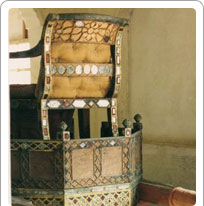Vibrant Rajasthan - Tour to the Land of History, Legends, Hotels....
- Pushkar Fair Tour Package
- Classical North India Tour Package with Nepal
- Palace on Wheels
- Colorful Heritage Rajasthan Tour Package
- Forts and Palaces of Rajasthan Tour Package
- Jewels of Rajasthan Tour Package
- Rajasthan Cultural Tour Package
- Splendours Of Rajasthan
- Pushkar Fair Tour with Golden Triangle
Mehrangarh Fort Museum
The museum at Mehrangarh Fort is a large, world class museum divided into galleries each with a different theme and extremely well maintained by the Mehrangarh Museum Trust. Through the exhibits in the museum, it is easy to form a clear picture of the royal way of living. The museum also has handicrafts shops selling the wares made by local craftspeople.
The galleries at the museum are:
Elephant Howdas: Elephants have always found favour with royalty, due to their majesty, calm temperament and loyalty. The royals in India sat on an elephant in a howdah, to maintain the regal bearing and travel in comfort. The howda (a wooden framed seat) was normally a two compartment seat, large enough to include the mahout and bodyguards. The howdas were decorated with gold and silver embossed sheets that were a piece of art. The howdas on display at Mehrangarh museum are considered to be the best in India.
The pride of the display is a unique and priceless historical piece, the silver howdah of the Mughal Emperor Shahjahan, presented as a mark of special honour to Maharaja Jaswant Singh, along with an elephant and a hundred horses, on 18th December 1657.
Palanquins: Palanquins (Palki in Sanskrit) were a popular means of travel for the women of nobility who observed 'purdah'. These palkis had decorated covers and metal screens to peep outside. The display of palkis at this museum is among the most elaborate in Rajasthan. These include palanquins used for both women and men. Men used open palkis to get around. Palkis of particular note are Pinjas, the covered palanquin beautifully decorated with lacquer paintwork and Rajat khasa, a beautiful lotus shaped royal silver palanquin used by the Maharajas.
The Treasures: The finest collection of art of the Rathore dynasty that ruled over Jodhpur (erstwhile Mewar) is on display in this room. These include arms, textiles, decorative arts, manuscripts, paintings & headgear including the sword of Mughal Emperor Akbar, the Maha Dol Planquin, embroidered tent hanging, woven tent screens and the printed Jama (coat). This room is known as the Daulat Khana.
The Armoury: Armoury from each period of Jodhpur's history, including Sword hilts in jade, rhine horn, silver, ivory, shields studded with rubies, emeralds and pearls, guns with gold and silver work on barrels are on display. Also see the personal swords of Emperors, e.g. the Khanda of Rao Jodha, weighing over seven pounds, the sword of Akbar the Great and the sword of Timur the Lame.
The Paintings: The paintings gallery has a collection of the finest of Jodhpur's art. Every ruler encouraged painting in his court and the influence of Rajputs as well as Mughals is clearly visible in the works.

- The museum at Mehrangarh Fort is a large, world class museum divided into galleries...
Jodhpur Hotels
Jodhpur's Special
- Forts and Monuments
- Umaid Bhawan Palace
- Mehrangarh Fort
- Jaswant Thanda
- Phool Mahal
- Museums
- Mehrangarh Fort Museum
- Lakes
- Guda Lake
- Parks
- Mandore Garden
- Fairs & Festivals
- Kite Festival
- Nagaur Fair
- Marwar Festival
- Near Jodhpur
- Osian
- Machiya Safari Park
Hot Selling Tours
- Kerala - God's Own Country
- Rajasthan Heritage Tour
- Sikkim Delight Tour
- Jewels Of Rajasthan Tour
- The Treasures of India & Nepal
- Temple and Spices Tour
- Best Of Two Cultures (Karnataka & Kerala)
- Backwater Beach Tours Kerala
- Golden Triangle Tour with Ajanta and Ellora
- Enchanting Kerala Tour
- Colourful Heritage Tour of Rajasthan
- Classical North India with Nepal
- Classical North India Tour
- Exotic Kerala Tour
- Rajasthan Forts And Palaces Tour
- Exotic South India Tour with Backwaters of Kerala
- Golden Triangle with Ranthambore Tour
- Golden Triangle Tour 5-6






